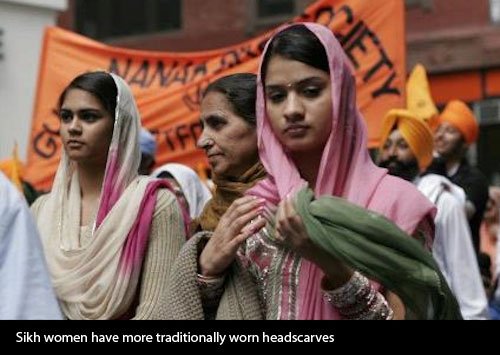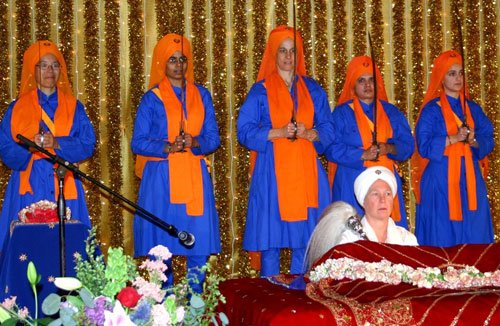
The turban is worn by millions of Sikhs - traditionally, mostly male ones. Now many Sikh women are donning it, too. Why?
"Doing this has helped me stay grounded and focused on what my responsibilities are as a human being."
Devinder is in her early 40s. She's a slender, tall British-Indian Sikh woman. She works as a teaching assistant at her local school in Ilford, north-east London. You can't help but notice that she wears a turban, or what's commonly known within Sikhism as a dastar.
The turban is the one thing that identifies a Sikh more than any other symbol of their faith.
An edict handed down in 1699 by the 10th Sikh Guru, Gobind Singh, requires Sikhs to not cut their hair. The turban, part of the Bana or military uniform at that time, was used to help keep the long hair and protect a Sikh's head.
However, in line with its military tradition, it's something that has always been a masculine symbol and almost exclusively worn by men, not women. That is until now, it seems.
"I wasn't always like this," says Devinder holding up a photo album of her younger years. "I used to have cut black curls, wear makeup - go out and do what people do on nights out… but it never sat comfortably with me even then."
Seven years ago Devinder decided to become fully baptised into the Sikh faith. She stopped cutting her hair, and began wearing a tall white wrapped turban.
"People told me I shouldn't do it and that it will hold me back. The elders felt it's something that Sikh women didn't do. But wearing my turban, I feel free and it pushes me forwards to be the best I can be every day."
As well as wearing the turban, Devinder lets her facial and bodily hair grow naturally as well. It's something she speaks confidently about.

"Asian women are naturally hairy so it was difficult to let go at first and let go of the expectations society places upon what a woman should look like," she says.
"But letting it go was so empowering. It's a way of saying this is who I am, this is how God made me and putting that above what society expects of me."
It impossible to know exactly how many Sikh women are now wearing the turban, but at a time when some Sikh men are deciding to cut their hair, Devinder is among a growing number of Sikh women deciding to wear one.
Doris Jakobs, professor in religious studies at Waterloo University in Canada, has done some of the most in-depth research in this area. She says that women tying turbans are mostly Sikhs living outside of their traditional homeland of the Punjab in India.
"This is something that the younger generation in the diaspora are doing. It's a sign of religiosity in which some Sikh women are no longer content with just wearing a chuni (headscarf). Wearing a turban is so clearly identifiable with being Sikh and so women now also want that clear visual sign that they are also Sikh as well. It's a play on the egalitarian principle of Sikhism."
Post-9/11, many Sikhs faced discrimination and have even been attacked after being mistaken for Muslims. Some in the community say they have turned to the turban as they feel it helps give them an individual identity.

Sikhism at a glance
-
Sikhism is a monotheistic religion, founded in the 16th Century in the Punjab by Guru Nanak and is based on his teachings, and those of the nine gurus who followed him
-
The Sikh scripture is the Guru Granth Sahib, a book that Sikhs consider a living Guru
-
There are 20 million Sikhs in the world, most of whom live in the Punjab province of India. The 2011 census recorded 432,000 Sikhs in the UK
Jasjit Singh, a research fellow at Leeds University, has spent the last few years interviewing women who have begun to wear the turban. He says there are many reasons why they are doing it.
"Some say it helps with meditation and others say its part of a Sikh's uniform," he says.
"I found that many young girls see this as a way of reclaiming equality within the religion. The Punjabi community is still very patriarchal but these girls tell me that Guru gave a uniform to all Sikhs - and so why shouldn't they wear the turban as well."
The idea is an interesting one. Some might find it curious that, in order to seek equality, a woman might dress like a traditional Sikh man. But others argue a woman wearing a turban is a sign of empowerment.
Sarabjoth Kaur, 25, from Manchester, is one of them. She began wearing a turban two years ago. She appears draped in royal blue robes with a matching tightly wrapped turban. It has a metal shaster, a type of ancient Vedic weapon wedged into the front.
Sarabjoth, a former bhangra dancer, says her faith became stronger after she witnessed devout white Sikhs wearing the turban whilst worshipping in India. She strongly defends the right for women to wear the turban.

"People in my family weren't comfortable with it. They thought it would be difficult to get a job or how would I find a good husband," she says. "Before we had to change to fit in with British society.
"Sikh women are meant to be strong. They're still khalsa (saint soldiers of the Guru) and the khalsa isn't differentiated on gender. When I tie my turban every morning I want to see my Guru. I feel a great sense of pride when I see my reflection as I think this is what my Guru looked like, this is what the khalsa looks like."
You can hear the full report on Sikh women and the turban on BBC Radio World Service's Heart and Soul programme, 09:30 GMT on Sunday 14 February - or catch up on BBC iPlayer Radio

